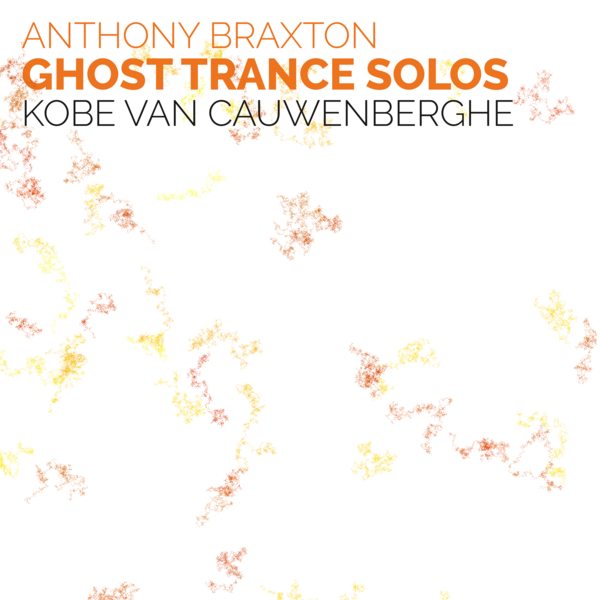
Anthony Braxton
Ghost Trance Solos
Kobe Van Cauwenberghe
atd10
Over the course of a long career spanning free jazz and experimentalism, Anthony Braxton has continually questioned the systems by which music is notated, named and played. There is a warmth and humour to Van Cauwenberghe’s response to Braxton’s Ghost Trance Music that seems fully in keeping with the project’s radical, friendly openness.
Critical acclaim
Anthony Braxton’s Ghost Trance Music has been explained as his interpretation of Native American ritualistic circle or ghost dances, the means by which a people connected to their ancestors. The music appears to be unbounded, and it exists before the musicians take the stage and continues long after the performance has concluded. If we carry that concept into the 21st century, the music could have, maybe should have been, the score to The Matrix science fiction film series… Belgian guitarist Kobe Van Cauwenberghe steps inside that matrix with his performance of three Braxton compositions with his Ghost Trance Solos by layering loops and electronics over his guitar in real time. The effect is astonishing and as hypnotic as an ensemble performance.
Tracks
| 1 | Composition No. 255 | 20:59 |
| 2 | Composition No. 284 | 23:35 |
| 3 | Composition No. 358 | 21:51 |
| TT | 66:26 |
This recording was supported by the Artesis Plantijn University College Antwerpen. Thanks also to the Tri-Centric Foundation.
Liner notes
Over the course of a long career spanning free jazz and experimentalism, Anthony Braxton has continually questioned the systems by which music is notated, named and played. He describes the results as ‘event-spaces’ in which performer agency is encouraged. Listeners, too, are integral to the network: Braxton refers to them as ‘friendly experiencers’.
Braxton began giving performances of Ghost Trance Music in the mid-1990s; the last was devised in 2006. He took inspiration from the ritualistic circle or ghost dances through which displaced Native American communities reconnected with their ancestors. Braxton always gives his works a diagram as a title, accompanied by a number to keep track. Ghost Trance Music comprises more than 150 pieces situated between composition Nos. 181 and 363.
Every piece of Ghost Trance Music begins with a ‘primary melody’, a long sequence of notes played by all the musicians involved. From there Braxton provides a set of instructions: a circle indicates improvisation; a triangle directs the performer to secondary compositions for trio; a square allows them to turn to any composition from Braxton’s catalogue. As a result, his scores have been likened to ‘a musical superhighway’, placing the performer firmly in the driving seat. Or, as Braxton puts it, ‘Rather than have a composition that goes from “Mary had a little lamb” and then it’s finished, it’s like “Mary had …” and then there’s a lot different things she could have had’.
In ‘Ghost Trance Solos’ guitarist Kobe Van Cauwenberghe provides an overview of how Braxton’s approach to the series changed over time. Having initially used a stable underlying pulse, Braxton then introduced rhythmic interruptions (as in No. 255), which intensified in the next phase as graphic elements were also introduced to the primary melody (No. 284). In the later compositions, each beat is either subdivided or completely obscured by irregular polyrhythms (No. 358).
The holistic aspect of Braxton’s work might seem to be tested by Van Cauwenberghe playing alone rather than with an ensemble. Yet this does not sound or feel like solo music. In order to generate what Braxton refers to as a ‘field of activities’ for one instrument, Van Cauwenberghe uses loops and live electronics to build up layers of musical material. Parts of the ‘square’ and ‘triangle’ passages were pre-recorded and sampled but the recording sessions themselves were not overdubbed. What is heard on disc, then, is very close to a live performance. Everything develops simultaneously and spontaneously, the non-human agents functioning much as a collaborator might. The sequence of pre-recorded materials is not set, allowing for their random distribution. The guitar lines are entangled with spoken and half-sung phrases that also overlap in No. 255, where notes from the primary melody are given vowels or numbers, what Braxton called ‘Syntactical Ghost Trance Music’. In No. 358 words enter via No. 171 for solo piano, which includes text from an imaginary press conference by a park ranger. There is a warmth and humour to Van Cauwenberghe’s response to Braxton’s Ghost Trance Music that seems fully in keeping with the project’s radical, friendly openness.
Laura Tunbridge